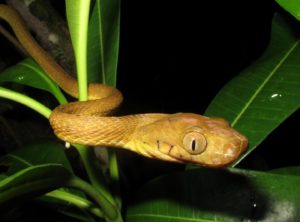They form a kind of lasso and then slide upwards piece by piece: researchers have discovered a previously unknown way of snake movement in the notorious brown night tree snake. Using this method, the invasive reptiles can even climb thick, smooth metal masts. This explains how the night tree snakes on the island of Guam reach the nests of endangered birds and cause occasional power outages, the scientists report.
They are particularly successful without legs: The physique of snakes has become a real hit in evolutionary history. The loss of limbs enabled a high degree of adaptability in locomotion. The reptiles were able to conquer many different habitats on earth: some species meander through holes in the ground, others whiz across the ground or glide smoothly through water. Many tropical species have also developed a great talent for climbing, which allows them to wind their way up to the highest treetops. The brown night tree snake (Boiga irregularis) is particularly notorious for this climbing ability.
Invasive climbing artist
The original range of this up to three meter long snake is northern Australia and the islands to the north of it. But humans also took the climbing artist to distant islands in the Pacific. It spread particularly on Guam since the 1940s and caused devastating losses, especially among the native bird species. US scientists are currently trying to save at least the last of the Micronesia starlings of Guam through a conservation project. They support the birds by providing nesting boxes that are attached to masts. The night tree snakes can easily wind up on the slender poles. In order to prevent them from looting the incubators, the researchers first attached oven-tube-like protective caps made of metal to the ends of the masts. Against the background of the previously known climbing techniques of the snakes, they assumed that they would not be able to negotiate these wide and smooth structures.

But as plundered nests showed, that was a mistake. In order to find out how the nocturnal adders managed to overcome the obstacle, the researchers then evaluated the images from surveillance cameras. “We had been watching about four hours of video material when suddenly a snake appeared, which formed something like a lasso around the broad protective cylinder,” reports co-author Thomas Seibert from Colorado State University in Fort Collins. “The animal then slowly pushed its body up the smooth surface. We watched this part of the video about 15 times in disbelief. No snake behavior that I had ever seen was comparable to it, ”says the biologist.
Unknown climbing technique
As the researchers explain, snakes usually climb steep, wide, and smooth branches or pipes using some sort of concertina method, where they bend sideways to develop a point of contact at specific points. But the process now observed differs markedly from these techniques. The scientists were able to document this precisely through climbing experiments with test snakes. The analyzes of high-resolution videos showed how the snakes form a loop from their body using the lasso technique, which enables a single comprehensive contact area around the cylindrical object. The animals then use wave-like movements to produce small, upwardly directed bulges from the lasso, which they slowly pull up.
Apparently this is a procedure that the animals probably only use when it is really worth it, because it seems to be very strenuous: When moving with the lasso, the scientists observed that the snakes often paused and breathed heavily. “Although you can climb in this mode, your capabilities are reaching their limits,” says co-author Bruce Jayne of the University of Cincinnati. The night tree snakes probably developed this technique in order to be able to climb the trunks of some tree species with particularly smooth bark. The observations now also explain how these snakes get on electricity pylons and thereby occasionally cause power outages on the island of Guam, the researchers say.
They now also want to test the limits of the mobility of other species of snakes to learn more about the capabilities of these amazing reptiles. As for the protection of the endangered bird species on Guam, the results can now be used to develop protective devices that invasive climbers cannot cope with, the scientists say. “Understanding what the snakes can and cannot get through has a direct impact on barriers design to reduce the spread and some of the harmful effects of this highly invasive species,” concludes Jayne.
Source: Colorado State University, Article: Current Biology, doi: 10.1016 / j.cub.2020.11.050
Video: A brown night tree snake climbs a smooth pole using the lasso method. (Credit: Thomas Seibert)